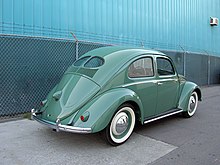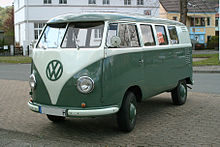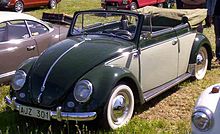 | |
| Industry | Automotive |
|---|---|
| Founded | 28 May 1937 |
| Founder(s) | Ferdinand Porsche |
| Headquarters | Wolfsburg, Germany |
| Area served | Worldwide |
| Key people | Martin Winterkorn: Chairman of the Board of Management, Ferdinand Piëch: Chairman of Volkswagen Supervisory Board |
| Products | Cars |
| Production output | |
| Revenue | (US$119 billion USD) |
| Employees | 368,500 (2009) |
| Parent | Volkswagen Group |
| Website | Volkswagen.com (International) |
Volkswagen (abbreviated VW) is a German automobile manufacturer and is the original and biggest-selling marque of the Volkswagen Group, which now also owns the Audi, Bentley, Bugatti, Lamborghini, SEAT, and Škoda marques and the truck manufacturer Scania.[1]
Volkswagen means "people's car" in German, where it is pronounced [ˈfɔlksˌvaːɡən]. Its current tagline or slogan is Das Auto (in English The Car).
History
- For vehicle time line tables, see: Volkswagen (timeline),
1937–1945: People's Car project becomes Kübelwagen
Volkswagen was originally founded in 1937 by the Nazi trade union, the German Labour Front (Deutsche Arbeitsfront).[2] In the early 1930s German auto industry was still largely composed of luxury models, and the average German rarely could afford anything more than a motorcycle. Seeking a potential new market, some car makers began independent "peoples' car" projects – Mercedes' 170H, Adler's AutoBahn, Steyr 55, Hanomag 1,3L, among others. The trend was not new, as Béla Barényi is credited with having conceived the basic design in the middle 1920s. Josef Ganz developed the Standard Superior (going as far as advertising it as the "German Volkswagen").[3][broken citation] Also, in Czechoslovakia, the Hans Ledwinka's penned Tatra T77, a very popular car amongst the German elite, was becoming smaller and more affordable at each revision. In 1933, with many of the above projects still in development or early stages of production, Adolf Hitler declared his intentions for a state-sponsored "Volkswagen" program. Hitler required a basic vehicle capable of transporting two adults and three children at 100 km/h (62 mph). The "People's Car" would be available to citizens of the Third Reich through a savings scheme at 990 Reichsmark, about the price of a small motorcycle (an average income being around 32RM a week).[4]
Despite heavy lobbying in favour of one of the existing projects, Hitler chose to sponsor an all-new, state-owned factory. The engineer chosen for the task was Ferdinand Porsche. By then an already famed engineer, Porsche was the designer of the Mercedes 170H, and worked at Steyr for quite some time in the late 1920s. When he opened his own design studio he landed two separate "Auto für Jedermann" (car for everybody) projects with NSU and Zündapp, both motorcycle manufacturers. Neither project come to fruition, stalling at prototype phase, but the basic concept remained in Porsche's mind time enough, so on 22 June 1934, Dr. Ferdinand Porsche agreed to create the "People's Car" for Hitler.[citation needed]
Changes included better fuel efficiency, reliability, ease of use, and economically efficient repairs and parts. The intention was that ordinary Germans would buy the car by means of a savings scheme ("Fünf Mark die Woche musst du sparen, willst du im eigenen Wagen fahren" – "Five Marks a week you must put aside, If in your own car you want to ride"), which around 336,000 people eventually paid into. Prototypes of the car called the "KdF-Wagen" (German: Kraft durch Freude – "strength through joy"), appeared from 1936 onwards (the first cars had been produced in Stuttgart). The car already had its distinctive round shape and air-cooled, flat-four, rear-mounted engine. The VW car was just one of many KdF programs which included things such as tours and outings. The prefix Volks— ("People's") was not just applied to cars, but also to other products in Europe; the "Volksempfänger" radio receiver for instance. On 28 May 1937, the Gesellschaft zur Vorbereitung des Deutschen Volkswagens mbH (sometimes abbreviated to Gezuvor[5]) was established by the Deutsche Arbeitsfront. It was later renamed "Volkswagenwerk GmbH" on 16 September 1938.[6]
Erwin Komenda, the longstanding Auto Union chief designer, developed the car body of the prototype, which was recognizably the Beetle known today. It was one of the first to be evolved with the aid of a wind tunnel, in use in Germany since the early 1920s.
The building of the new factory started 26 May 1938 in the new town of KdF-Stadt, now called Wolfsburg, which had been purpose-built for the factory workers. This factory had only produced a handful of cars by the time war started in 1939. None was actually delivered to any holder of the completed saving stamp books, though one Type 1 Cabriolet was presented to Hitler on 20 April 1938 (his 49th birthday).
War meant production changed to military vehicles, the Type 82 Kübelwagen ("Bucket car") utility vehicle (VW's most common wartime model), and the amphibious Schwimmwagen which were used to equip the German forces. As was common with much of the production in Nazi Germany during the war, slave labor was utilized in the Volkswagen plant. The company would admit in 1998 that it used 15,000 slaves during the war effort. German historians estimated the that 80% of Volkswagen's wartime workforce was slave labor.[citation needed] Many of the slaves were reported to have been supplied from the concentration camps upon request from plant managers. A lawsuit was filed in 1998 by survivors for restitution for the forced labor.[7] Volkswagen would set up a voluntary restitution fund.[8]
1945: British Army, Major Ivan Hirst, unclear future
The company owes its post-war existence largely to one man, British Army officer Major Ivan Hirst, REME. In April 1945, KdF-Stadt, and its heavily bombed factory were captured by the Americans, and subsequently handed over to the British, within whose occupation zone the town and factory fell. The factories were placed under the control of Oldham-born Hirst. At first, the plan was to use it for military vehicle maintenance. Since it had been used for military production, and had been in Hirst's words a "political animal" rather than a commercial enterprise – technically making it liable for destruction under the terms of the Potsdam Agreement, the equipment was in time intended to be salvaged as war reparations. Hirst painted one of the factory's cars green and demonstrated it to British Army headquarters. Short of light transport, in September 1945 the British Army was persuaded to place a vital order for 20,000. The first few hundred cars went to personnel from the occupying forces, and to the German Post Office.
Some British Service personnel were allowed to take their VW Beetles back to the United Kingdom when they were demobilised, and one of the very first Beetles brought back in that way (UK registration number JLT 420) is still owned by Peter Colborne-Baber, the son of the original proprietor of the UK's first official Volkswagen Importer, Colborne Garages of Ripley, Surrey.[9]
By 1946 the factory was producing 1,000 cars a month, a remarkable feat considering it was still in disrepair. Owing to roof and window damage, rain stopped production and new vehicles were bartered for steel required for more production.
The car, and its town changed their Second World War-era names to "Volkswagen", and "Wolfsburg" respectively, and production was increasing. It was still unclear what was to become of the factory. It was offered to representatives from the British, American and French motor industries. Famously, all rejected it. After an inspection of the plant, Sir William Rootes, head of the British Rootes Group, told Hirst the project would fail within two years, and that the car "is quite unattractive to the average motorcar buyer, is too ugly and too noisy … If you think you're going to build cars in this place, you're a bloody fool, young man".[citation needed] In an ironic twist of fate, Volkswagen would manufacture a locally built version of Rootes's Hillman Avenger in Argentina in the 1980s, long after Rootes had gone bankrupt at the hands of Chrysler in 1978—the Beetle outliving the Avenger by over 30 years.
Ford representatives were equally critical: the car was "not worth a damn," according to Henry Ford II, the son of Edsel Ford, although he did reportedly look at the possibility of taking over the VW factory, but dismissed the idea as soon as he looked up Wolfsburg on the map and found it to be too close for comfort to the East German border.[citation needed]
In France, Citroën started the 2CV on a similar marketing concept. Meanwhile, in Italy, the Fiat 500 "Topolino" was developed.
[edit] 1945 to 1948: survival in Allied-occupied Germany
In Occupied Germany, the Allies followed the Morgenthau Plan, to remove all German war potential, by complete or partial pastoralisation. As part of this, in the Industrial plans for Germany, the rules for which industry Germany was to be allowed to retain were set out. German car production was set at a maximum of 10% of the 1936 car production numbers.[10]
As mentioned above, the Volkswagen factory at Wolfsburg came under British control in 1945; it was to be dismantled and shipped to Britain. Thankfully for Volkswagen, no British car manufacturer was interested in the factory; "the vehicle does not meet the fundamental technical requirement of a motor-car … it is quite unattractive to the average buyer … To build the car commercially would be a completely uneconomic enterprise".[11] The factory survived by producing cars for the British Army instead. Allied dismantling policy changed in late 1946 to mid 1947, although heavy industry continued to be dismantled until 1951. In March 1947 Herbert Hoover helped change policy by stating: "There is the illusion that the New Germany left after the annexations can be reduced to a 'pastoral state'. It cannot be done unless we exterminate or move 25,000,000 people out of it".[12] Thanks to the protection of British Army Major Ivan Hirst, Volkswagen survived the perilous times, and became part of the German economic recovery.
1948 onwards: icon for the West German regeneration


From 1948, Volkswagen became a very important element, symbolically and economically, of West German regeneration. Heinrich Nordhoff (1899–1968), a former senior manager at Opel who had overseen civilian and military vehicle production in the 1930s and 1940s, was recruited to run the factory in 1948. In 1949 Major Hirst left association with the company, as it had now been re-formed as a trust, controlled by the West German government, and the government of the State of Lower Saxony. Apart from the introduction of the Volkswagen Type 2 commercial vehicle (van, pick-up and camper), and the VW Karmann Ghia sports car, Nordhoff pursued the one-model policy until shortly before his death in 1968.
Volkswagens were first exhibited and sold in the United States in 1949, but only sold two units in America that first year. On its entry to the U.S. market, the VW was briefly sold as a "Victory Wagon". Volkswagen of America was formed in April 1955 to standardise sales and service in the United States. Production of the Type 1 Volkswagen Beetle increased dramatically over the years, the total reaching one million in 1955.
Volkswagens in Canada – VW Canada ordered their first cars on 10 July 1952. (shipping order 143075) The order consisted of 12 vehicles, (3) model 11C, a black, green, and sandcolor (3) 11GS, a chestnut brown and two azure blue, (2) 24A-M51 in red, (1)21A in blue, (1) 23A in blue, (1) 22A beige color, and one Ambulance. Volkswagen Products were seen in Canada for the first time at the Canadian National Exhibition in August 1952 and were accepted enthusiastically. The first shipment of cars reached Toronto in December 1952. By 1955 sales were on a basis that warranted the building of the fine Volkswagen plant on a 32-acre (130,000 m2) site on Scarboro's Golden Mile. To this, a 60,000-square-foot (5,600 m2) building with administration, showrooms, service, repairs and parts, an addition of 60,000-square-foot (5,600 m2) was built in 1957, with storage for $4,000,000 of parts. (See 1959 Canadian Register of Commerce & Industry held in the Western Libraries at the University of Western Ontario, London, Ontario.)
Sales soared—thanks in part to the famous advertising campaigns by New York advertising agency Doyle, Dane Bernbach. Led by art director Helmut Krone, and copywriters Julian Koenig and Bob Levinson, Volkswagen advertisements became as popular as the car, using crisp layouts and witty copy to lure the younger, sophisticated consumers with whom the car became associated. Even though it was almost universally known as the Beetle (or the Bug), it was never officially labelled as such by the manufacturer, instead referred to as the Type 1. The first reference to the name Beetle occurred in U.S. advertising in 1968, but not until 1998 and the Golf-based New Beetle would the name be adopted by Volkswagen.[dubious – discuss]
Although the car was becoming outdated, during the 1960s and early 1970s, Am







No comments:
Post a Comment